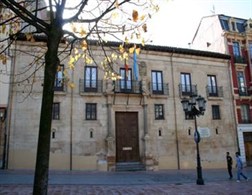The Counts of Toreno and their palace in Oviedo
The Queipo de Llanos, Lords of Toreno and afterwards counts, descend directly from Diego Rodríguez Muñoz, named, on account of his fame, “el Can”, one of the most important nobles from Asturias in the Middle Ages. One of his descendants, Álvaro Alfonso, married Aldara Rodríguez de Llano in the fifteenth century who was his distant cousin and also a descendant of “el Can”. These were the parents of Lope Queipo Rodríguez, the first to use both names. At the end of the sixteenth century one of the descendants, Juan Queipo Tineo, the Lord of the house of the Queipo, of the castle and the cities of La Muñona and Montes Murielos, patron of the parishes of San Juan de Vega and Santa Maria Rengos Xedred, alférez-mayor (lieutenant) and heir to the city of Cangas de Tineo and governor of its council, married another cousin of his, Catalina de Llano y Valdés, the daughter of the Lord of Salas. These two marriages united the lands of the Queipo, the Llano and the Valdés.
 The palace of the counts of Toreno in Oviedo is the work of the architect Gregorio de la Roza, who built it in 1673 for the Malleza Dóriga family. It is located at number 5 of the Plaza de Porlier, in the capital city of the principality of Asturias. Its most significant elements are the assymetrical façade, with a stone base and the portal, with columns and coats of arms on the sides of the central balcony. It is completed by niches in the form of embrasures, five balconies and windows. In the inside there is a courtyard with Tuscan columns and a monumental stone staircase on the right. It has been declared a historical-artistic monument and housed the provincial public library and the provincial historical archive from February 1958 to November 1987. Currently it is the home of the Royal Institute of Asturian Studies (RIDEA), an organization founded in 1946 with the aim of stimulating research and drawing attention to the cultural and artistic heritage of the Asturian region.
The palace of the counts of Toreno in Oviedo is the work of the architect Gregorio de la Roza, who built it in 1673 for the Malleza Dóriga family. It is located at number 5 of the Plaza de Porlier, in the capital city of the principality of Asturias. Its most significant elements are the assymetrical façade, with a stone base and the portal, with columns and coats of arms on the sides of the central balcony. It is completed by niches in the form of embrasures, five balconies and windows. In the inside there is a courtyard with Tuscan columns and a monumental stone staircase on the right. It has been declared a historical-artistic monument and housed the provincial public library and the provincial historical archive from February 1958 to November 1987. Currently it is the home of the Royal Institute of Asturian Studies (RIDEA), an organization founded in 1946 with the aim of stimulating research and drawing attention to the cultural and artistic heritage of the Asturian region.
